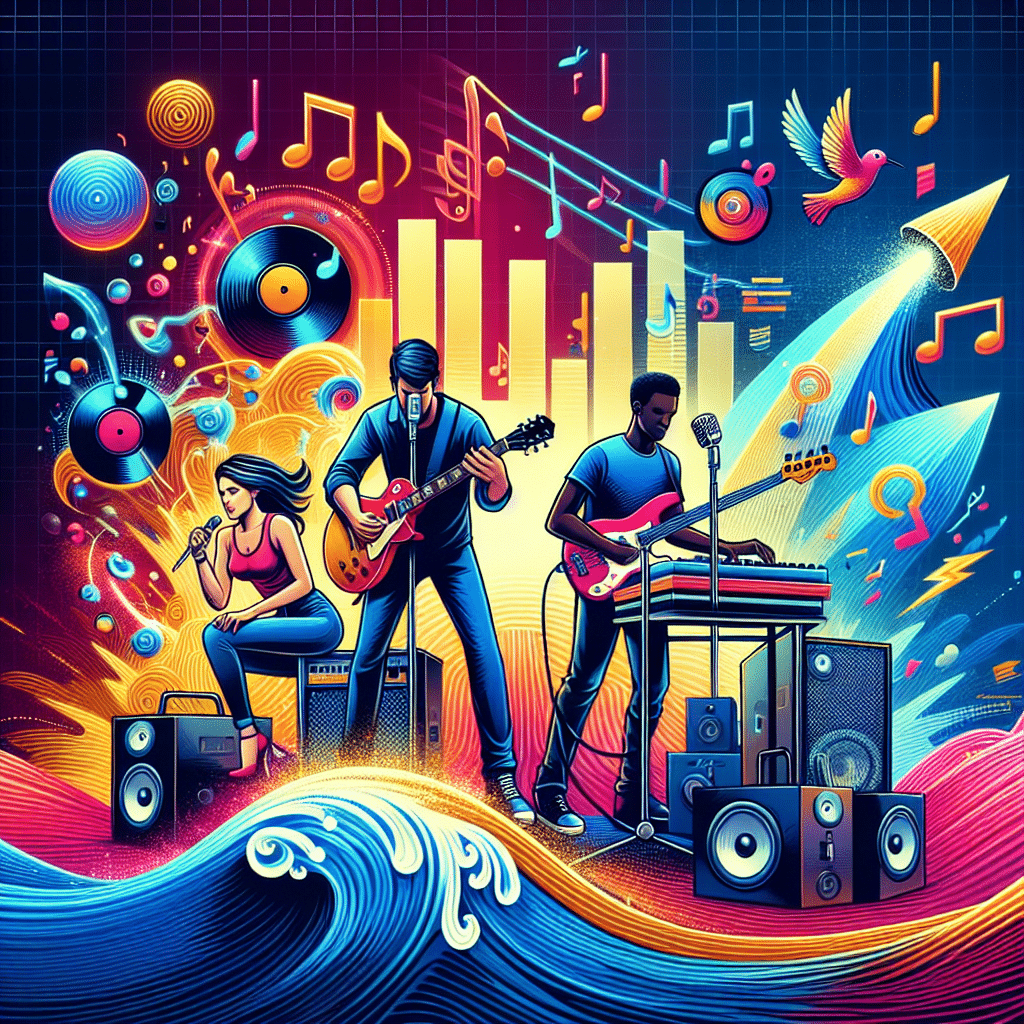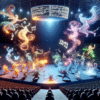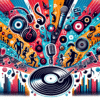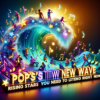Pop Music’s New Wave: Rising Artists Making Chart History

Introduction
In recent years, pop music has undergone a seismic shift, ushering in a "new wave" of rising artists who are not only changing the soundscape but also redefining what it means to be a pop star in the digital age. These artists are gaining chart success through innovative songwriting, diverse influences, and strong connections with their fan base facilitated via social media platforms. This article explores the historical context, highlights key artists, delves into current trends, and examines the broader cultural impacts of this emerging pop music movement.
Historical Context
The evolution of pop music is distinctively marked by various cultural and technological shifts. Initially dominated by artists from established music institutions, pop has been democratized through the rise of digital platforms. The late 2000s and early 2010s saw significant changes with the advent of streaming services like Spotify and Apple Music, which reshaped how music is distributed and consumed. Moreover, social media platforms like TikTok, Instagram, and YouTube have become critical tools for new artists to showcase their talents and connect with global audiences.
Today, the concept of “pop” has expanded, encompassing a wide range of genres and influences, from hip-hop to electronic dance music (EDM), K-pop, and even indie. The genre's traditional boundaries have blurred, allowing rising stars to carve unique niches that reflect contemporary social themes and individual narratives.
Key Artists
See Also: Summer Jams: The Ultimate Playlist of 2023’s Catchiest Pop Hits
Summer Jams: The Ultimate Playlist of 2023’s Catchiest Pop HitsSeveral artists are at the forefront of this new wave of pop music, each contributing to the chart-topping momentum with their distinctive sounds and perspectives.
Olivia Rodrigo
Bursting onto the scene with her debut single “drivers license” in early 2021, Olivia Rodrigo quickly became a household name. Her confessional songwriting, rooted in personal experiences of heartbreak and adolescence, resonated with a generation navigating the complexities of young adulthood. The success of her debut album, SOUR, which topped charts worldwide and broke numerous streaming records, distances Rodrigo from typical teen pop tropes, showcasing raw emotion over polished perfection. Her unique blend of pop-infused alt-rock has not only placed her on the charts but has also inspired countless young artists.
Billie Eilish
Billie Eilish epitomizes the crossover potential of pop music infused with transcendental themes and experimental sounds. Arriving on the music scene with her haunting debut single “Ocean Eyes,” Eilish has continued to push boundaries with her genre-defying work. Accompanied by her brother Finneas, Eilish’s music often explores themes of mental health, identity, and environmental consciousness. With multiple Grammy wins, her influence extends beyond music. She represents a new archetype of pop star who embraces vulnerability and authenticity, deeply resonating with audiences.
The Kid LAROI
Originating from Australia, The Kid LAROI initially gained fame through his collaborations with the rap community but later transcended to pure pop stardom with his hit “STAY,” featuring Justin Bieber. His ability to blend pop melodies with hip-hop rhythms and deeply personal lyrics has allowed him to resonate with a wide audience, making him a significant figure in today's music landscape. His rapid rise to stardom exemplifies how versatility in musical genres has become essential for chart success.
See Also: The Soundtrack of Our Lives: Pop Songs That Define 2023
The Soundtrack of Our Lives: Pop Songs That Define 2023Doja Cat
Doja Cat skillfully navigates pop, rap, and R&B, consistently delivering infectious hooks and relatable lyrics. With her eclectic style and genre-blurring music, she has captivated the music industry and audiences alike. Hits like “Say So” and “Kiss Me More” have crossed genres, accumulating awards and commercial success. Doja Cat's creative approach to music videos and social media presence emphasizes her multi-faceted talents, making her one of the leading figures in this new pop revolution.
Current Trends
The new wave of pop music demonstrates varying trends that highlight the shifts in artistic expression and audience engagement.
Genre Blending
Today's rising artists are increasingly adopting a genre-blending approach, refreshing the sound of pop music. The integration of hip-hop beats, electronic elements, and world music influences allows for a diverse listening experience, catering to a multitude of tastes. This trend not only widens the appeal of pop music but also encourages collaboration among artists from different backgrounds.
See Also: The Clash of the Titans: Iconic Artists Compete for Chart Supremacy
The Clash of the Titans: Iconic Artists Compete for Chart SupremacyAuthenticity and Vulnerability
Contemporary pop artists are prioritizing authenticity in their music. Lyrical themes often emphasize mental health struggles, personal growth, and emotional honesty, resonating with audiences who appreciate relatable content. The willingness to share vulnerable experiences establishes deeper connections with fans and builds long-lasting loyalty.
Digital Influence
Social media platforms have become instrumental in shaping the careers of new artists. TikTok, for instance, has transformed how songs go viral, often leading to unexpected chart success. Many rising stars use these platforms to engage with their audience, fostering community and feedback that directly influences their creative processes.
Cultural Impact
The new wave of pop music is reshaping cultural narratives, influencing fashion, language, and social discourse. These rising artists are not just entertainers; they are voices of a generation, addressing pressing societal issues such as mental health awareness, climate change, and representation.
Shaping Social Movements
See Also: Streaming vs. Sales: How Digital Changes the Game on Pop Charts
Streaming vs. Sales: How Digital Changes the Game on Pop ChartsArtists like Billie Eilish have used their platforms to advocate for social justice and mental health awareness. Their willingness to speak openly about personal and societal issues encourages listeners to engage in meaningful conversations, thus fostering a new wave of activism within the music scene.
Redefining Beauty Standards
With their diverse representations of beauty and individuality, new wave artists challenge traditional beauty norms. Through their art, they celebrate uniqueness and authenticity, encouraging fans to embrace and express their true selves.
Conclusion
The significance of Pop Music’s New Wave cannot be overstated. Rising artists are redefining the genre with their inventive sounds and authentic narratives. They are not only reshaping the music chart landscape but also encouraging social dialogue and cultural change. As we witness this exciting evolution, it’s clear that the future of pop music lies in the hands of innovative creators ready to break down barriers and inspire the next generation.
FAQs
Q1: What defines the 'new wave' of pop music?
See Also: Catchy Beats and Powerful Voices: Exploring the Best Pop Artists of 2023
Catchy Beats and Powerful Voices: Exploring the Best Pop Artists of 2023A1: The 'new wave' of pop music is characterized by genre-blending, authenticity in songwriting, and heavy reliance on social media for marketing and audience engagement.
Q2: How have social media platforms changed the music industry?
A2: Social media platforms allow artists to share their music directly with fans, gather feedback, and create viral moments that can lead to chart success, influencing contemporary music trends.
Q3: Which rising artists should I listen to for a taste of modern pop?
A3: Some notable rising artists include Olivia Rodrigo, Billie Eilish, The Kid LAROI, and Doja Cat, each bringing unique sounds and themes to the pop genre.
Q4: Are all new pop artists young?
A4: While many new pop artists are younger, the term 'new wave' is not limited to age but rather describes artists who are innovating and shaping current trends in pop music.
See Also: Pop's New Wave: Rising Stars You Need to Listen to Right Now
Pop's New Wave: Rising Stars You Need to Listen to Right NowQ5: What impact do these artists have on society?
A5: Rising pop artists often address critical societal issues in their music, influence cultural trends, and promote movements focused on authenticity, mental health, and social justice.
If you want to know other articles similar to Pop Music’s New Wave: Rising Artists Making Chart History you can visit the category Pop.
